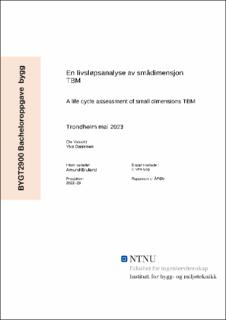| dc.contributor.advisor | Bruland, Amund | |
| dc.contributor.advisor | Log, Sindre | |
| dc.contributor.author | Vasslid, Ole | |
| dc.contributor.author | Danielsen, Ylva | |
| dc.date.accessioned | 2023-07-14T17:20:16Z | |
| dc.date.available | 2023-07-14T17:20:16Z | |
| dc.date.issued | 2023 | |
| dc.identifier | no.ntnu:inspera:146719958:64534287 | |
| dc.identifier.uri | https://hdl.handle.net/11250/3079057 | |
| dc.description.abstract | Energibehovet i verden er stadig økende, og det er noe vi i Norge må forholde oss til. I norge er vi opptatte av å bevare naturen og det skal tas hensyn til i forbindelse med byggeprosjekter. Dette skaper utfordringer for videre utbygging og for norsk vannkraftindustri. En løsning på dette problemet er tunnelboremaskiner. Å bruke tunnelboremaskiner til å lage vanntunneler er både effektivt og lite inngripende i naturen, da inngrepet er begrenset til inn- og utløp. Lite påvirkning av naturen er viktig, men det å se på CO2-utslippene til et slikt prosjekt er også en viktig faktor for miljøpåvirkningen.
I denne oppgaven har det blitt gjennomført en livsløpsanalyse av boreprosessen til en vannkraftsverktunnel. Det har blitt sett på hvordan ulike tunneldimensjoner, bergmasser, utslipp knyttet til transport av ansatte og sikringsforbruk påvirker CO2-utslippene tilknyttet tunnelen. Alle de ulike faktorene har blitt beregnet hver for seg, blitt sammenlignet med hverandre før de ble satt sammen til et samlet utslipp.
Resultatene fra de ulike tverrsnittene og bergmassene blir satt sammen til samlete utslipp. Det samlete utslippet har blitt sammenlignet med et eksisterende, ferdigstilt prosjekt, Mork kraftverk, som har blitt boret med en liten TBM. | |
| dc.description.abstract | The world's energy demand is continuously increasing, and that is something we as Norwegians has to relate to as well. In Norway, we are concerned with great protection of nature against construction work. This presents challenges for the Norwegian hydropower industry. One solution to this problem is tunnel boring machines (TBMs). Using TBMs to create water tunnels is both efficient and minimally impact of the nature, with the intervention limited to the inlet and outlet areas. Minimizing the impact on nature is crucial and to consider the CO2 emissions of such a project is also an important factor in assessing its environmental impact.
Therefore, a life cycle assessment of the drilling process for a hydropower tunnel has been conducted. It has been studied how different factors such as tunnel dimensions, rock types, emissions associated with employee transportation, and consumption of support materials were examined to assess their impact on CO2 emissions related to the tunnel. Each of these factors was calculated separately and compared against each other before being combined to determine the overall emissions.
The results obtained from different cross sections and rock masses were collected to determine the overall emissions. These overall emissions were then compared to an existing completed project, Mork hydroelectric power plant, which was drilled with a small dimension TBM. | |
| dc.language | nob | |
| dc.publisher | NTNU | |
| dc.title | En livsløpsanalyse av smådimensjon TBM | |
| dc.type | Bachelor thesis | |
